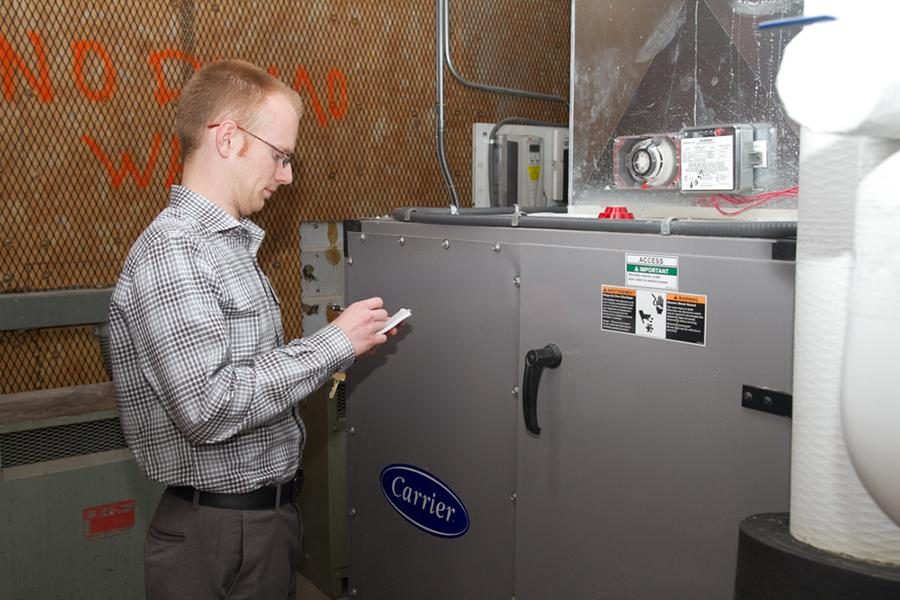Green minds think alike
TISD cuts down on energy costs by incorporating new program
Photo by Maria Frohnhoefer
Local Energy Specialist Mark Kerby jots down numbers pertaining to the campus’ energy usage.
December 20, 2015
Flipping off a light switch could save your school $750,000 over the next five years. Cenergistic, The Energy Conservation Company, has been making this dream a reality for school districts, colleges, universities and hospitals across the nation since 1986.
“Cenergistic is a company that currently has 1,360 clients nationwide and so far has saved school districts and colleges and hospitals $4 billion,” Texarkana Independent School District’s local energy specialist Mark Kerby said. “The goal for this district [TISD] is to have a total saving of cost avoidance of $750,000 over the next five years.”
Kerby, who was trained by the Dallas-based company, Cenergistic, is a Texas High alumnus who graduated in 2009. His job is to make sure that the project is working all day, every day and in all buildings.
“The greatest thing about this program is that there is zero risk for the client,” Kerby said. “If we don’t reach the savings of $750,000 that we have guaranteed, Cenergistic will pay that amount to TISD.”
For two years before the program is implemented, Cenergistic uses proprietary tools and technology to collect the data to create a baseline of utility consumption. This is used to calculate the cost avoidance and is then compared to the long term goal of lowering expenditures for utilities.
“Currently, through local initiatives, we feel like we have been very frugal as far as the expenditures we incur, and we are very good stewards of taxpayer dollars,” former principal and current Executive Director of Support Operations Casey Nichols said. “However, at the same time, we are never satisfied, and we want to do better.”
TISD administrators are enthusiastic about working with the company to lower spending without budgeting extra dollars. The only cost is drawn from the existing utility budget that will contain a surplus as a result of working with Cenergistic.
“This is a wonderful, risk-free opportunity for us to partner with one of the leading companies in this type of endeavor,” Nichols said. “We can capture and recognize the savings that are out there.”
Cenergistic is a behaviorally-based program. This means that a large part of their main mode or operation is to educate the custodial staff, administration and maintenance about ways to conserve energy-thus saving money that is otherwise spent on utility bills and using it where administration sees fit.
“The only way that this program will succeed is if everyone buys into it and jumps on board,” Kerby said. “What we are really looking for is an extra set of eyes.”
Along with the custodial and maintenance staff, students and teachers are encouraged to flip off light switches when leavings rooms and make sure that appliances not in use are completely powered down.
“We are not asking students to sacrifice safety or comfort; we would never do that, they are our top priorities,” Nichols said. “Cenergistic has found out over time that people are actually more comfortable once this program is implemented.”
Using EnergyCAP® software and other tools, Cenergistic specialists have discovered and fixed details that affect amenities, such as situations in which the room temperature may be correct but the humidity levels are slightly off, making the occupants uncomfortable.
“There is a lot of experience and resources that this company brings to the table,” Nichols said. “Traditionally, local school districts do not have these advanced tools, but through a partnership with Cenergistic, they are able to tap into them to ensure safety and comfort.”
One way TISD is planning on becoming more efficient is to reprogram the settings for heating and cooling so they won’t be running when no one is on campus.
“What we’re doing is targeting places that are unoccupied and eliminating that wasted energy,” Kerby said.
Cenergistic’s goal is to produce savings of 20 to 30 percent without limiting the campus environment. This means that there is no need to worry about security lights being turned off to conserve energy and money that can be used in classrooms around campus..
“We are excited to put the money saved back into the classroom where it will directly affect student achievement,” Nichols said. “The conservative goal of three quarters of a million dollars over five years will have an enormous impact on the educational environment.”














